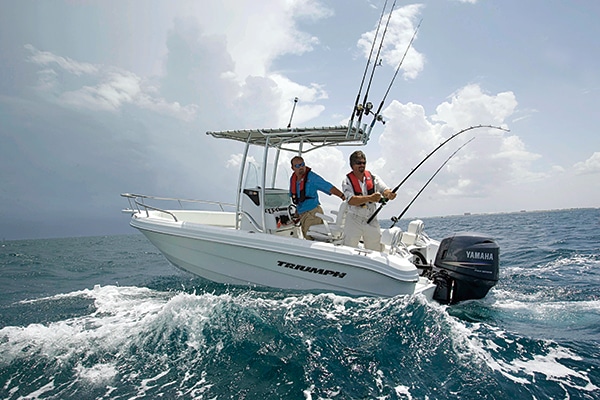
inflatable vest
There’s no doubt the U.S. Coast Guard does a great job protecting our waterways and enforcing maritime law. But as with any federal agency, ironclad rules sometimes butt heads with practicality. I found that out while outfitting my guide boat in the 1990s. Due to limited storage in that flats skiff, I wanted to use compact inflatable life vests instead of the bulky Type I foam ones required for commercial operation.
I called the Coast Guard headquarters in Washington, D.C., and asked the duty safety officer if there were any exceptions to the style of PFD required on for-charter boats. “No” was the curt reply. It didn’t matter that if my clients fell out of the boat, they could stand up in the 3-foot depths I normally fished. So I endured cramped compartments until my next, larger-boat purchase.
Recreational anglers aren’t bound by those same restrictions, although many do have similar storage issues. Inflatable life vests are much easier to stow, and may offer better safety features than the Mae West foam alternatives. But across all the different styles of PFDs, Coast Guard ratings of inflatables can be confusing. Geoff Grover, Mustang Survival’s vice president of marketing, explains the choices.
Looking Good
“The advantages of inflatables are increased comfort and less volume in terms of taking up space on a vessel,” Grover says. “A lot of people don’t wear personal-flotation devices because they don’t look cool. But the designs have come a long way in the past five years, and those produced by us and other manufacturers are awesome-looking, so people like to wear them. The early versions were available only in red or blue, but now multiple styles and colors offer aesthetics as well as performance.”
Looks aside, the most critical aspect of an inflatable vest is whether it keeps you afloat when you need it most. Grover says those that are manually deployed are best suited for slow movement, like kayak fishing, where you’re more likely to tip over and fall into the water than you are to experience a sudden, tragic accident. The Type III fanny-pack style — which is strictly manual and requires the user to slip the collar over the head after inflation — is suitable for kayaking or when trolling at slow speeds.
Stay Current
Manual vests are easy to maintain because they don’t have a lot of components. As long as the CO2 cylinder remains intact, the vest is usable, and the cylinders last indefinitely if they aren’t punctured by the inflator mechanism. Grover warns that they still require periodic inspection.
“You still need to inspect the shell and inflation bladder, just as you would an auto-inflator,” he says. “The chance of a fish hook or sharp object like a knife penetrating the bladder is just as high.” On either type of vest, Grover recommends using the oral-inflation tube regularly to check the bladder integrity. That way a CO2 cartridge isn’t wasted, yet inflation can be verified. Be sure to leave the vest inflated for at least two hours for a thorough check.
Select to Fit
Manual vests average $10 to $20 less in price than auto-inflatables, but they’re not appropriate if something bad happens and you end up in the water unexpectedly. Automatic vests inflate by one of two mechanisms. The most common style uses a dissolvable tablet or bobbin that disintegrates when it gets wet, firing the inflator mechanism. The hydrostatic style reacts to water pressure. Mustang Survival is the only company that currently makes Coast Guard-approved hydrostatic vests.
“What that means is you can spray a hydrostatic vest with a hose, or even wear it in the shower, and it’s not going to go off until it’s at least 4 inches under the water, and the pressure sets it off,” Grover says.
As long as the inspection window shows green, a hydrostatic vest is ready for use. Bobbin-based auto-inflatables need to be checked every six to 12 months to ensure the tablet is intact. Inspection frequency should be increased in regions with high humidity or rain, like Florida and the Pacific Northwest. Stowing a bobbin vest in compartments that get wet could also inadvertently set off the inflator mechanism.
Heads Up
Consider the buoyancy rating when purchasing an inflatable vest. The Coast Guard is currently studying its rating system, and Grover expects changes, but the rule of thumb is to go with a higher rating depending on where you do the majority of your fishing. If you’re an offshore canyon runner who often encounters big seas, opt for an offshore vest with 35 pounds of buoyancy. That extra lift will help keep your head above the surface in big waves.
If bays and flats are more your style, one of the vests that provides 22 to 26 pounds of flotation is a good choice. The smaller cylinder used makes these models lighter and more comfortable without sacrificing safety. According to Grover, the amount of buoyancy with a standard Type II orange vest is only 15 pounds. The commercial Type I vests provide 22 pounds of buoyancy.
“So for a reference point, all inflatables provide more flotation than any of the foam vests,” Grover says. “The Coast Guard generally wants to see 22 pounds minimum in inflatables, but I expect the approval ratings might change radically in the next couple of years to reflect performance features — such as self-righting — versus buoyancy levels.”
Even though inflatable life vests are appealing because of their stowability, Grover says there’s a better reason for using them. “Our goal is to make it comfortable, make it easy to maintain, and make it good-looking. If you’re buying one just to meet a compliance requirement, you’re missing the point. We want people to actually wear them so they’ll be safe at the end of the day.”









